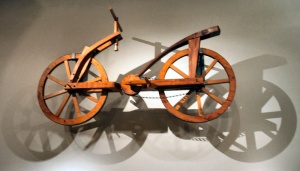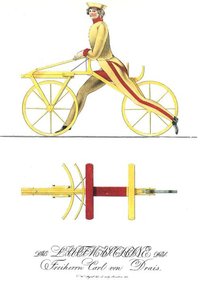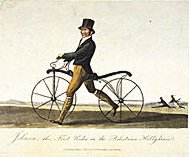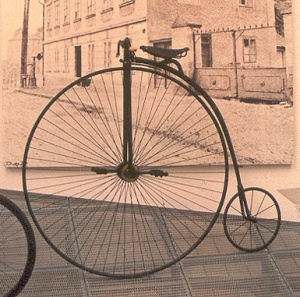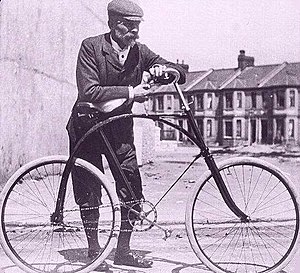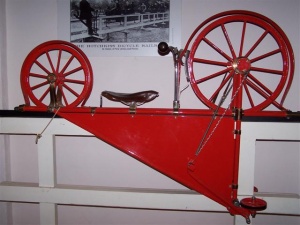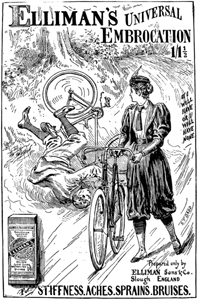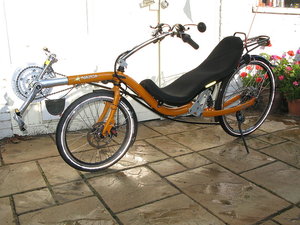Difference between revisions of "History of the bicycle"
m |
m |
||
| Line 7: | Line 7: | ||
There are several early but unreliable claims for the invention of bicycle-like machines. | There are several early but unreliable claims for the invention of bicycle-like machines. | ||
| − | The earliest comes from an illustration found in a church window in [[Stoke Poges]], installed in the [[16th Century]], showing a naked [[angel]] on a bicycle-like device | + | The earliest comes from an illustration found in a church window in [[Stoke Poges]], installed in the [[16th Century]], showing a naked [[angel]] on a bicycle-like device and from a sketch said to be from 1493 and attributed to [[Gian Giacomo Caprotti]], a pupil of [[Leonardo da Vinci]]. Hans-Erhard Lessing recently showed this last assertion to be a purposeful fraud. However, the authenticity of the bicycle sketch is still vigorously maintained by the Italian cultural bureaucracy still believing the misled Prof. Augusto Marinoni, a lexicographer, who was entrusted by the Commissione Vinciana of Rome with the transcription of da Vinci's Codex Atlanticus. |
Later, and equally unreliable, is the allegation ''Comte'' de Sivrac developed a ''célérifère'' in 1791, demonstrating it at the [[Palais-Royal]] in France. The ''célérifère'' supposedly had two wheels set on a rigid wooden frame and no steering, directional control being limited to that attainable by leaning. A rider was said to have to sat astride the machine and pushed it along using alternate feet. We now know a two-wheeled ''célérifère'' never existed (though there were four-wheelers) and it was a misinterpretation by the well known French journalist Louis Baudry de Saunier in 1891. | Later, and equally unreliable, is the allegation ''Comte'' de Sivrac developed a ''célérifère'' in 1791, demonstrating it at the [[Palais-Royal]] in France. The ''célérifère'' supposedly had two wheels set on a rigid wooden frame and no steering, directional control being limited to that attainable by leaning. A rider was said to have to sat astride the machine and pushed it along using alternate feet. We now know a two-wheeled ''célérifère'' never existed (though there were four-wheelers) and it was a misinterpretation by the well known French journalist Louis Baudry de Saunier in 1891. | ||
Revision as of 17:35, 23 April 2009
Vehicles for human transport that have two wheels and require balancing by the rider date back to the early 19th century. The first means of transport making use of two wheels, and thus the archetype of the bicycle, was the German draisine dating back to 1817. The term bicycle was coined in France in the 1860s.
Earliest unverifiable history
There are several early but unreliable claims for the invention of bicycle-like machines.
The earliest comes from an illustration found in a church window in Stoke Poges, installed in the 16th Century, showing a naked angel on a bicycle-like device and from a sketch said to be from 1493 and attributed to Gian Giacomo Caprotti, a pupil of Leonardo da Vinci. Hans-Erhard Lessing recently showed this last assertion to be a purposeful fraud. However, the authenticity of the bicycle sketch is still vigorously maintained by the Italian cultural bureaucracy still believing the misled Prof. Augusto Marinoni, a lexicographer, who was entrusted by the Commissione Vinciana of Rome with the transcription of da Vinci's Codex Atlanticus.
Later, and equally unreliable, is the allegation Comte de Sivrac developed a célérifère in 1791, demonstrating it at the Palais-Royal in France. The célérifère supposedly had two wheels set on a rigid wooden frame and no steering, directional control being limited to that attainable by leaning. A rider was said to have to sat astride the machine and pushed it along using alternate feet. We now know a two-wheeled célérifère never existed (though there were four-wheelers) and it was a misinterpretation by the well known French journalist Louis Baudry de Saunier in 1891.
1817 to 1819: the draisine or velocipede
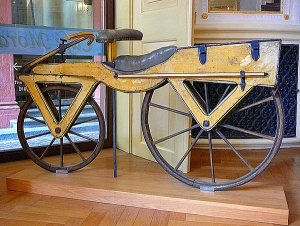
The first reliable claim for a practically-used bicycle belongs to German Baron Karl von Drais, a civil servant to the Grand Duke of Baden in Germany. Drais invented his Laufmaschine (German for "running machine") of 1817 that was called Draisine (English) or draisienne (French) by the press. Karl von Drais patented this design in 1818 which was the first commercially successful two-wheeled, steerable, human-propelled machine commonly called a velocipede, nick-named hobby-horse or dandy horse. It was initially manufactured in Germany and France. It was constructed almost entirely of wood. Hans-Erhard Lessing found from circumstantial evidence that Drais' interest in finding an alternative to the horse was the starvation and death of horses caused by crop failure in 1816 ("eighteen hundred and froze to death," following the volcanic eruption of Tambora). On his first reported ride from Mannheim on June 12, 1817, he covered 13 km (eight miles) in less than an hour. The wooden draisine weighed 22 kg (48 pounds), had brass bushings within the wheel bearings, a rear-wheel brake and 152 mm (6 inches) of trail of the front-wheel for a self-centering castor effect. This design was welcomed by mechanically minded men daring to balance and several thousand copies were built and used, primarily in Western Europe and in North America. Its popularity rapidly faded when, partly due to increasing numbers of accidents, some city authorities began to prohibit its use. However in 1866 Paris a Chinese visitor named Bin Chun could still observe foot-pushed velocipedes.
Shortly after, the concept was picked up by a number of British cartwrights; the most notable being Denis Johnson of London. We can assume a name change occurred when Johnson patented his vehicle and named it “pedestrian curricle” or “velocipede,” but the public preferred nick-names like “hobbyhorse,” after the children’s toy or, worse still, “dandyhorse,” after the foppish men who often rode them. Johnson's machine was an improvement on Drais's, being notably more elegant: his wooden frame had a serpentine shape instead of Drais's straight one, which allowed the use of larger wheels without raising the seat higher. During the summer of 1819 the "hobby-horse", thanks in part to Johnson's marketing skills and better patent protection, became the craze and fashion in London society. The dandies, the Corinthians of the Regency, adopted it, therefore the poet John Keats referred to it as "the nothing" of the day. Riders wore out their boots surprisingly rapidly, and the fashion ended within the year, after riders on sideways were fined two pounds.
Nevertheless, Drais' velocipede provided the basis for further developments: in fact, it was a draisine which inspired a french metalworker around 1863 to add rotary cranks and pedals to the front-wheel hub, to create the first pedal-operated "bicycle" as we today understand the word.
The 1820s to 1850s: an era of 3 and 4-wheelers


Though technically not part of 2-wheel "bicycle" history, the intervening decades of the 1820s-1850s witnessed many developments concerning human-powered vehicles often using technologies similar to the draisine, even if the idea of a workable 2-wheel design, requiring the rider to balance, had been dismissed. These new machines had three wheels (tricycles) or four (quadricycles) and came in a very wide variety of designs, using pedals, treadles and hand-cranks, but these designs often suffered from high weight and high rolling resistance. However, Willard Sawyer in Dover successfully manufactured a range of treadle operated 4 wheel vehicles and exported them worldwide in the 1850s.
The 1830s: the reported Scottish inventions
The first mechanically-propelled 2-wheel vehicle was believed to have been built by Kirkpatrick MacMillan, a Scottish blacksmith, in 1839. A nephew later claimed that his uncle developed a rear-wheel drive design using mid mounted treadles connected by rods to a rear crank, similar to the transmission of a steam locomotive. Proponents associate him with the first recorded instance of a bicycling traffic offence, when a Glasgow newspaper reported in 1842 an accident in which an anonymous "gentleman from Dumfries-shire... bestride a velocipede... of ingenious design" knocked over a pedestrian in the Gorbals and was fined five British shillings. However, the evidence connecting this with MacMillan isn't even circumstantial, since the artisan MacMillan wouldn't have been termed a gentleman. A similar machine was said to have been produced by Gavin Dalzell of Lesmahagow . The first documented producer of rod-driven 2-wheelers was Thomas McCall, of Kilmarnock in 1869. The design could not compete with the front-crank velocipede of the Lallement/Michaux type, however, despite McCall's all steel version of 1869.
1860s and the Michaux or "Boneshaker"
The first really popular and commercially successful design was a French one (an example of the style is held in the Museum of Science and Technology (Ottawa)). Initially developed around 1863, it sparked a fashionable craze briefly during 1868-70. Its design was simpler than the Macmillan bicycle, it used rotary cranks and pedals mounted to the front wheel hub. Pedaling made it easier for riders to propel the machine at speed, but the rotational speed limitation arising from stability and comfort concerns would lead to the large front wheel of the "penny farthing". It was difficult to pedal the wheel that was used for steering. The use of metal frames reduced the weight and provided sleeker, more elegant designs, and also allowed mass-production. Different braking mechanisms were used depending on the manufacturer. In England, the velocipede earned the name of "bone-shaker" because of its rigid frame and iron banded wheels that resulted in a "bone-shaking experience for riders."
The velocipede's renaissance began in Paris during the late 1860s. Its early history is complex and has been shrouded in some mystery, not least because of conflicting patent claims: all that has be stated for sure is that a French metalworker attached pedals to the front wheel; at present, the earliest year bicycle historians agree on is 1864. The identity of the person who attached cranks is still an open question at International Cycling History Conferences (ICHC). The claims of Ernest Michaux and of Pierre Lallement, and the lesser claims of rear-pedaling Alexandre Lefebvre, have their supporters within the ICHC community.

Bicycle historian David V. Herlihy documents that Lallement claimed to have created the pedal bicycle in Paris in 1863. He had seen someone riding a draisine in 1862 then originally came up with the idea to add pedals to it. It is a fact that he filed the earliest and only patent for a pedal-driven bicycle, in the USA in 1866. Lallement's patent drawing shows a machine which looks exactly like Johnson's draisine, but with the pedals and rotary cranks attached to the front wheel hub, and a thin piece of iron over the top of the frame to act as a spring supporting the seat, for a slightly more comfortable ride.
By the early 1860s, the blacksmith Pierre Michaux, besides producing parts for the carriage trade, was producing "vélocipède à pédales" on a small scale. The wealthy Olivier brothers Aimé and René were students in Paris at this time, and these shrewd young entrepreneurs adopted the new machine. In 1865 they travelled from Paris to Avignon on a velocipede in only eight days. They recognized the potential profitability of producing and selling the new machine. Together with their friend Georges de la Bouglise, they formed a partnership with Pierre Michaux, Michaux et Cie ("Michaux and company"), in 1868, avoiding use of the Olivier family name and staying behind the scenes, lest the venture prove to be a failure. This was the first company which mass-produced bicycles, replacing the early wooden frame with one made of two pieces of cast iron bolted together -- otherwise, the early Michaux machines look exactly like Lallement's patent drawing. Together with a mechanic named Gabert in his hometown of Lyon, Aimé Olivier created a diagonal single-piece frame made of wrought iron which was much stronger, and as the first bicycle craze took hold, many other blacksmiths began forming companies to make bicycles using the new design. Velocipedes were expensive, and when customers soon began to complain about the Michaux serpentine cast-iron frames breaking, the Oliviers realized by 1868 that they needed to replace that design with the diagonal one which their competitors were already using, and the Michaux company continued to dominate the industry in its first years.
On the new macadam paved boulevards of Paris it was easy riding, although initially still using what was essentially horse coach technology. It was still called "velocipede" in France, but in the United States, the machine was commonly called the "bone-shaker," because its ride was so rough. Later improvements included solid rubber tires and ball bearings. Lallement had left Paris in July 1865, crossed the Atlantic, settled in Connecticut and patented the velocipede, and the number of associated inventions and patents soared in the US. The popularity of the machine grew on both sides of the Atlantic and by 1868-69 the velocipede craze was strong in rural areas as well. Even in a relatively small city such as Halifax, Canada, there were five velocipede rinks, and riding schools began to opening throughout many major urban centres. Essentially, the velocipede was a stepping stone that created a market for bicycles that led to the development of more advanced and efficient machines.
However, the Franco-Prussian war of 1870 destroyed the velocipede market in France, and the "bone-shaker" enjoyed only a brief period of popularity in the United States, which ended by 1870. There is debate among bicycle historians about why it failed in the United States, but one explanation is that American road surfaces were much worse than European ones, and riding the machine on these roads was simply too difficult. Certainly another factor was that Calvin Witty had purchased Lallement's patent, and his royalty demands soon crippled the industry. The UK was the only place where the bicycle never fell completely out of favor.
1870s: the high-wheel bicycle
The high-bicycle was the logical extension of the boneshaker, the front wheel enlarging to enable higher speeds (limited by the inside leg measurement of the rider), the rear wheel shrinking and the frame being made lighter. Frenchman Eugene Meyer is now regarded as the father of the High Bicycle by the ICHC in place of James Starley. Meyer invented the wire-spoke tension wheel in 1869 and produced a classic high bicycle design until the 1880s.
James Starley in Coventry added the tangent spokes and the mounting step to his famous bicycle named "Ariel." He is regarded as the father of the British cycling industry. Ball bearings, solid rubber tires and hollow-section steel frames became standard, reducing weight and making the ride much smoother. Depending on the rider's leg length, the front wheel could now have a diameter up to 60 in (1.5 m). This type of bicycle was retronymed the "ordinary" (since there were then no other kind) and was later nicknamed "penny-farthing" in England (a penny representing the front wheel, and a coin smaller in size and value, the farthing, representing the rear). They were fast, but unsafe. The rider was high up in the air and traveling at a great speed. If he hit a bad spot in the road he could easily be thrown over the front wheel and be seriously injured (two broken wrists were common, in attempts to break a fall) or even killed. "Taking a header" (also known as "coming a cropper"), which was not at all uncommon, was no laughing matter. The rider's legs were often caught underneath the handlebars, so falling free of the machine was often not possible. The dangerous nature of these bicycles (as well as Victorian mores) made cycling the preserve of adventurous young men. Elderly gentlemen preferred, and women had to ride, the more stable tricycles or quadricycles. Queen Victoria owned Starley's "Royal Salvo" tricycle, though there is no evidence she actually rode it.
Although French and English inventors modified the velocipede into the high-wheel bicycle, the French were still recovering from the Franco-Prussian war, so English entrepreneurs put the high-wheeler on the English market, and the machine became very popular there, Coventry, Oxford, Birmingham and Manchester being the centers of the English bicycle industry (and of the arms or sewing machine industries, which had the necessary metalworking and engineering skills for bicycle manufacturing, as in Paris and St. Etienne, and in New England). Soon bicycles found their way across the English Channel. By 1875, high-wheel bicycles were becoming popular in France, though ridership expanded slowly.
In the United States, Bostonians such as Frank Weston started importing bicycles in 1877 and 1878, and Pope started production of his "Columbia" high-wheelers in 1878, and gained control of nearly all applicable patents, starting with Lallement's 1866 patent. Pope lowered the royalty (licensing fee) previous patent owners charged, and took his competitors to court over the patents. The courts supported him, and competitors either paid royalties ($10 per bicycle), or he forced them out of business. There seems to have been no patent issue in France, where English bicycles still dominated the market. By 1884 high-wheelers and tricycles were relatively popular among a small group of upper-middle-class people in all three countries, the largest group being in England. Their use also spread to the rest of the world, chiefly because of the extent of the British Empire.
Pope also introduced mechanization and mass production (later copied and adopted by Ford and General Motors), vertically integrated, (also later copied and adopted by Ford), advertised aggressively (as much as ten percent of all advertising in U.S. periodicals in 1898 was by bicycle makers), promoted the Good Roads Movement (which had the side benefit of acting as advertising, and of improving sales by providing more places to ride), and litigated on behalf of cyclists[1] (It would, however, be Western Wheel Company of Chicago which would drastically reduce production costs by introducing stamping to the production process in place of machining, significantly reducing costs, and thus prices.) In addition, bicycle makers adopted the annual model change[2] (later derided as planned obsolescence, and usually credited to General Motors), which proved very successful.
Even so, bicycling remained the province of the urban well-to-do, and mainly men, until the 1890s, and were examples of conspicuous consumption.
The 1880s and 1890s
The development of the safety bicycle was arguably the most important change in the history of the bicycle. It shifted their use and public perception from being a dangerous toy for sporting young men to being an everyday transport tool for men -- and, crucially, women -- of all ages.
Aside from the obvious safety problems, the high-wheeler's direct front wheel drive limited its top speed. Accordingly, inventors tried a rear wheel chain drive. Although a Henry Lawson invented a rear-chain-drive bicycle in 1879 with his "bicyclette", it still had a huge front wheel and a small rear wheel. Detractors called it "The Crocodile", and it failed in the market.
John Kemp Starley, James's nephew, produced the first successful "safety bicycle" (again a retrospective name), the "Rover," in 1885, which he never patented. It featured a steerable front wheel that had significant castor, equally sized wheels and a chain drive to the rear wheel.
Widely imitated, the safety bicycle completely replaced the high-wheeler in North America and Western Europe by 1890. Meanwhile John Dunlop's reinvention of the pneumatic tire in 1888 had made for a much smoother ride on paved streets; the previous type were quite smooth-riding, when used on the dirt roads common at the time. As with the original velocipede, safety bicycles had been much less comfortable than high-wheelers precisely because of the smaller wheel size, and frames were often buttressed with complicated bicycle suspension spring assemblies. The pneumatic tire made all of these obsolete, and frame designers found a diamond pattern to be the strongest and most efficient design.
The chain drive improved comfort and speed, as the drive was transferred to the non-steering rear wheel and allowed for smooth, relaxed and injury free pedaling (earlier designs that required pedalling the steering front wheel were difficult to pedal while turning, due to the misalignment of rotational planes of leg and pedal). With better stability, lesser gyrscopic forces and easier pedaling, the rider more easily turned corners.
The pneumatic tire and the diamond frame improved rider comfort but do not form a crucial design or safety feature. A hard rubber tire on a bicycle is just as ridable but is bone jarring. The frame design allows for a lighter weight, and more simple construction and maintenance, hence lower price.
With four key aspects (steerability, safety, comfort and speed) improved over the penny farthing, bicycles become very popular among elites and the middle classes in Europe and North America in the middle and late 1890s. It was the first bicycle that was suitable for women, and as such the "freedom machine" (as American feminist Susan B. Anthony called it) was taken up by women in large numbers.
Bicycle historians often call this period the "golden age" or "bicycle craze." By the start of the 20th century, cycling had become an important means of transportation, and in the United States an increasingly popular form of recreation. Bicycling clubs for men and women spread across the U.S. and across European countries. Chicago's immigrant Adolph Schoeninger with his Western Wheel Works became the "Ford of the Bicycle" (ten years before Henry Ford) by copying Pope's mass production methods and by introducing stamping to the production process in place of machining, significantly reducing production costs, and thus prices. His "Crescent" bicycles thus became affordable for working people, and massive exports from the United States lowered prices in Europe. The Panic of 1893 wiped out many American manufacturers who had not followed the lead of Pope and Schoeninger, in the same way as the Great Depression would ruin carmakers who did not follow Ford.
In 1895 Annie Londonderry became the first woman to bicycle around the world.
The impact of the bicycle on female emancipation should not be underestimated. The diamond-frame safety bicycle gave women unprecedented mobility, contributing to their larger participation in the lives of Western nations. As bicycles became safer and cheaper, more women had access to the personal freedom they embodied, and so the bicycle came to symbolise the New Woman of the late nineteenth century, especially in Britain and the United States. Feminists and suffragists recognised its transformative power. Susan B. Anthony said, "Let me tell you what I think of bicycling. I think it has done more to emancipate women than anything else in the world. It gives women a feeling of freedom and self-reliance. I stand and rejoice every time I see a woman ride by on a wheel...the picture of free, untrammeled womanhood." In 1895 Frances Willard, the tightly-laced president of the Women’s Christian Temperance Union, wrote a book called How I Learned to Ride the Bicycle, in which she praised the bicycle she learned to ride late in life, and which she named "Gladys", for its "gladdening effect" on her health and political optimism. Willard used a cycling metaphor to urge other suffragists to action, proclaiming, "I would not waste my life in friction when it could be turned into momentum." [1]
The backlash against the New (bicycling) Woman was demonstrated when the male undergraduates of Cambridge University chose to show their opposition to the admission of women as full members of the university by hanging a woman in effigy in the main town square -- tellingly, a woman on a bicycle--as late as 1897.[2]
Since women could not cycle in the then-current fashions for voluminous and restrictive dress, the bicycle craze fed into a movement for so-called rational dress, which helped liberate women from corsets and ankle-length skirts and other encumbering garments, substituting the then-shocking bloomers.
The 20th Century
Cycling steadily became more important in Europe over the first half of the twentieth century, but it dropped off dramatically in the United States between 1900 and 1910. Automobiles became the preferred means of transportation. Over the 1920s, bicycles gradually became considered children's toys, and by 1940 most bicycles in the United States were made for children. In Europe cycling remained an adult activity, and bicycle racing, commuting, and "cyclotouring" were all popular activities. In addition, specialist bicycles for children appeared before 1916.
Bicycles continued to evolve to suit the varied needs of riders. The derailleur developed in France between 1900 and 1910 among cyclotourists, and was improved over time. Interestingly, only in the 1930s did European racing organizations allow racers to use derailleurs; until then they were forced to use a two-speed bicycle. The rear wheel had a cog on either side of the hub. To change gears, the rider had to stop, remove the wheel, flip it around, and remount the wheel. When racers were allowed to use derailleurs, racing times immediately dropped. See bicycle gearing.
At mid-century there were two predominant bicycle styles for recreational cyclists in North America. Heavyweight cruiser bicycles, preferred by the typical (hobby) cyclist, featuring balloon tires, pedal-driven "coaster" brakes and only one gear, were popular for their durability, comfort, streamline appearance, and a significant array of accessories (lights, bells, springer forks, speedometers, etc.). Lighter cycles, with hand brakes, thinner tires, and a three-speed hub gearing system, often imported from England, first became popular in the United States in the late 1950s. These comfortable, practical bicycles usually offered generator-powered headlamps, safety reflectors, kickstands, and frame-mounted tire pumps. In the United Kingdom, like the rest of Europe, cycling was seen as less of a hobby, and lightweight but durable bikes had been preferred for decades.
In the early 1980s, Swedish company Itera invented a new type of bicycle, made entirely of plastic. It was a commercial failure.
Bicycle sales in North America

In the late 1960s, spurred by Americans' increasing consciousness of the value of exercise and later the advantage of energy efficient transportation led to the American bike boom of the 1970s. Annual U.S. sales of adult bicycles doubled between 1960 and 1970, and doubled again between 1971 and 1975, the peak years of the adult cycling boom in the United States, eventually reaching nearly 17 million units. Most of the these sales were to new cyclists, who overwhelmingly preferred models imitating popular European derailleur-equipped racing bikes, variously called sports models, sport/tourers, or simply ten-speeds. These lighter bicycles, long used by serious cyclists and by racers, featured dropped handlebars, narrow tires, derailleurs gears, five to fifteen speeds, and a narrow 'racing' type saddle. By 1980, racing and sport/touring derailleur bikes dominated the market in North America.
Recumbent Bicycle
In 1934, the development of the bicycle was truncated by the UCI's banning of the recumbent bicycle from all forms of racing. This stemmed from discomfort at Francis Faure, a mere category 2 racer, humiliating many class 1 racers while riding Mochet's Velocar. The clear superiority of this frame geometry for level races made upright bicycle manufacturers (the sponsors of the UCI) uncomfortable, who lobbied for a ban. This motion was passed after a long and heated meeting, and by only a handful of votes in a near split decision. This resulted in the stagnation of the upright racing bike's frame geometry which has remained essentially unchanged for 70 years. This stagnation finally started to reverse with the formation of the International Human Powered Vehicle Association which holds races for "banned" classes of bicycle. One such vehicle currently holds the human powered speed record of 82mph on level ground.
Mountain bikes
Template:Main In 1981, the first mass-produced mountain bikes appeared, intended for use off-pavement over a variety of surfaces. The mountain bike was an immediate success, and mountain bikes flew off retailers' shelves during the 1980s, their popularity spurred by the novelty of all-terrain cycling and the increasing desire of urban dwellers to escape their surroundings via mountain biking and other extreme sports. These cycles featured sturdier frames, wider tires with large knobs for increased traction, a more upright seating position (to allow better visibility and shifting of body weight), and increasingly, various front and rear suspension designs. By 2000, mountain bike sales had far outstripped that of racing, sport/racer, and touring bicycles.
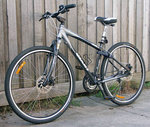
Hybrid bikes
In recent years, bicycle designs have trended towards increased specialization, as sales of bicycles to casual cyclists and commuters have grown. For the latter group, the industry responded with the hybrid bicycle, otherwise known as the city bike, cross bike, or commuter. These designs often combine elements of road racing and mountain bikes, using mid-level components. The term is used flexibly, with bikes ranging from fast and light racing-type bicycles with flat bars and other minimal concessions to casual use, to wider-tired bikes designed for primarily for comfort, load-carrying, and increased versatility over a range of different road surfaces.
While historically most bike frames have been steel, recent designs, particularly of high-end racing bikes, have made extensive use of carbon and aluminum frames.
Recent years have also seen a resurgence of interest in balloon tire cruiser bicycles for their low-tech comfort, reliability, and style.
In addition to influences derived from the evolution of American bicycling trends, European, Asian, and African cyclists have also continued to use traditional roadster bicycles, as their rugged design, enclosed chainguards, and dependable hub gearing make them ideal for commuting and utility cycling duty.
BMX
BMX, a form of cycling on specially designed bicycles which usually have 16 to 24-inch wheels (the norm being the 20-inch wheel), originated in the state of California, United States in the early 1970s, when teenagers imitated their motocross heroes on their bicycles. Children were racing standard road bikes off-road, around purpose-built tracks in the Netherlands. The 1971 motorcycle racing documentary On Any Sunday is generally credited with inspiring the movement nationally in the US. In the opening scene, kids are shown riding their Schwinn Stingrays off-road. It was not until the middle of that decade that the sport achieved critical mass, and manufacturers began creating bicycles designed specially for the sport.
It has grown into an international sport with several different disciplines.
Literature using ICHC results
- Cycle History vol. 1-17, Proceedings of the ICHC, 1990-2006
- David Gordon Wilson: Bicycling Science 3rd ed. 2004
- David V. Herlihy: Bicycle - The History. 2004
- Hans-Erhard Lessing: Automobilitaet - Karl Drais und die unglaublichen Anfaenge, 2003 (in German)
- Pryor Dodge: The Bicycle[3]. 1996 (French ed 1996, German eds 1997, 2002, 2007)
External links
- International Cycling History Conference (ICHC)
- Menotomy Vintage Bicycles - Antique bicycle photos, features, price guide and research tools.
- Metz Bicycle Museum in Freehold, NJ
- Myths and Milestones in Bicycle Evolution by William Hudson (accessed 2005-11-17)
- A Quick History of Bicycles from the Pedaling History Bicycle Museum (accessed 2005-01-06)
- 1911 Britannica article about the bicycle
- Bicyclette of Harry John Lawson
- VeloPress has published dozens of books on the history of cycling and the bicycle.
